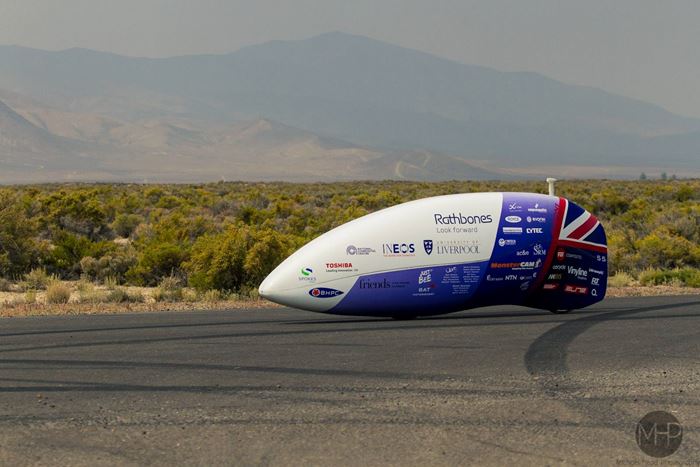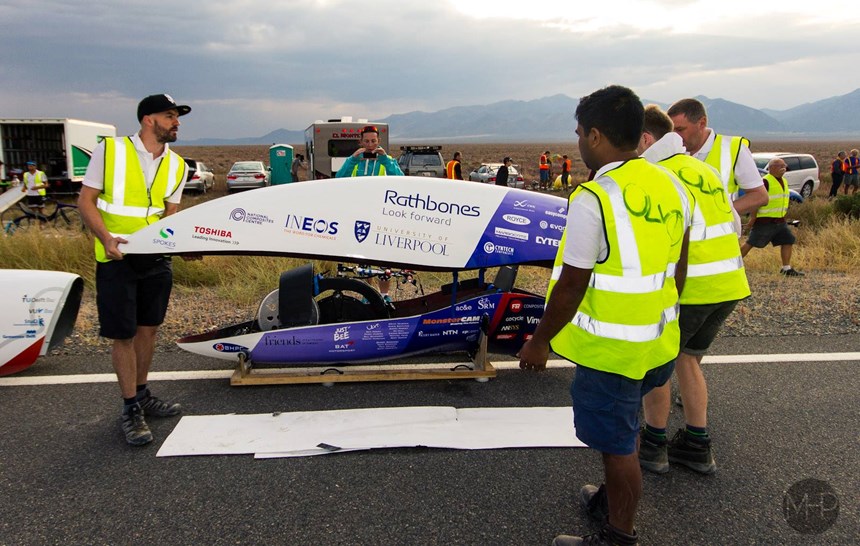Record-breaking land speed bicycle built with composites
The use of carbon fiber with Scott Bader’s Crestapol 1250LV infusion resin inside and out of the ARION1 land speed bicycle was extensive to achieve the strength to weight ratio needed for this type of speed challenge vehicle.
The University of Liverpool Velocipede (ULV) team designed and built its composites-intensive ARION1 land speed bicycle, which recently competed in the IHPVA World Human Power Speed Challenge. Now in its 16th year, this annual speed trial event attracts engineering teams from all over the world to test their designs and their rider’s endurance on the five-mile highway road at Battle Mountain, NV, US.
The ULV Team is made up of 16 undergraduate engineering students, all currently studying for their masters of mechanical engineering at the university. The 2015 attempt by the UVL Team made UK record-breaking history, with Ken Buckley setting a new human powered British land speed UK record of 75.03 mph piloting ARION1. However, the UVL Team were unable to match the Canadian Team AeroVelo, whose co-designer and rider, Todd Reichert, set a new IHPVA world record of 85.71 mph. Work on ARION2 is already underway by third year engineering students, for a ULV Team to compete again in 2016.
Details of the ARION1 design process
The design, engineering and materials selected for ARION1 focused on maximizing the aerodynamic performance and minimizing the overall weight of the vehicle. Structurally, it needs to handle the high force through the pedals driving the front wheel, support a single rider in a recumbent position and be stable in a straight line at speeds of over 80 mph. Its overall dimensions are approximately 2.8 meters long by 0.85 meters high and 0.5 meter wide. The rider or ‘pilot’ of the ARION1 velocipede sits almost flat with legs forward, completely enclosed inside a two-part carbon fiber composite body shell; the top half is removable to enable rider access.
The ULV team selected high performance lightweight composite materials and technologies, including Scott Bader’s carbon fiber compatible Crestapol 1250LV acrylic laminating resin for the outer shell and the carbon fiber composite (CFRP) chassis frame and Crestabond M1-20 primer-less structural adhesive to bond a variety of CFRP and metal parts used internally. Carbon fiber reinforcements, foam core materials and related design and processing technical support were provided by key sponsors of the student project including: Far-UK (West Bridgford, Nottingham, UK), Evonik (Essen, Germany), the UK National Composites Centre (NCC, Bristol, UK), as well as Scott Bader (Wollaston, Northampshire, UK).
The use of carbon fiber with Crestapol high performance resin inside and out of the ARION1 was extensive to achieve the strength to weight ratio needed for this type of speed challenge vehicle. The aerodynamic, rigid, thin walled, outer body shell is a sandwich laminate construction, molded using carbon fiber fabric, Crestapol 1250LV infusion resin and cut-to-size sections of ROHACELL IG rigid closed-cell PMI foam core. The entire internal frame and where possible other components, such as the seat, the front end section and push rods, were also CFRP fabricated parts.
For the critical h-shaped high load bearing frame section that fits around the front wheel supporting the wheel strut, drive chain system and pedals, Far-UK recommended an infused part design using its Axontex carbon fiber (CF) braid and foam core system with Crestapol 1250 LV resin. This very lightweight, high modulus, infused sandwich laminate specification was finally chosen by the ULV Team in preference to an epoxy prepreg based option that had also been tested; the Axontex CF braid system provided the flexibility needed to wrap around the curved sections and to accurately conform around machined sections of ROHACELL IG foam core. Dry lay-up and vacuum infusion at room temperature of the h-section was completed in just a few hours. The use of Crestapol 1250 LV enabled low temperature, rapid cure infusion of the part without any mould expansion. This was a critical factor for the team as the mold was also used as a jig to machine holes in the frame components, so maintaining mould dimensional accuracy was critical. The Crestapol infusion resin was specified as it is fully compatible with the CF braid and was simple to process at ambient temperature to provide the combination of very high strength, stiffness and toughness needed for the bike frame, with no requirement for any post curing.
To minimize weight, Crestabond M1-20 was used extensively throughout the interior of ARION1 to structurally bond CFRP, metal and wood parts, as well as a number of Big Head metal fasteners and fixings of the team’s own design. This included CF-CF bonding of the front end section and the lay shaft mounts into the outer body shell, as well as bonding the anodized aluminum head tube and crankset mounts to the carbon fiber front end member.
Related Content
Materials & Processes: Resin matrices for composites
The matrix binds the fiber reinforcement, gives the composite component its shape and determines its surface quality. A composite matrix may be a polymer, ceramic, metal or carbon. Here’s a guide to selection.
Read MoreMaterials & Processes: Fabrication methods
There are numerous methods for fabricating composite components. Selection of a method for a particular part, therefore, will depend on the materials, the part design and end-use or application. Here's a guide to selection.
Read MoreJeep all-composite roof receivers achieve steel performance at low mass
Ultrashort carbon fiber/PPA replaces steel on rooftop brackets to hold Jeep soft tops, hardtops.
Read MorePlant tour: Joby Aviation, Marina, Calif., U.S.
As the advanced air mobility market begins to take shape, market leader Joby Aviation works to industrialize composites manufacturing for its first-generation, composites-intensive, all-electric air taxi.
Read MoreRead Next
Composites end markets: Energy (2024)
Composites are used widely in oil/gas, wind and other renewable energy applications. Despite market challenges, growth potential and innovation for composites continue.
Read MoreFrom the CW Archives: The tale of the thermoplastic cryotank
In 2006, guest columnist Bob Hartunian related the story of his efforts two decades prior, while at McDonnell Douglas, to develop a thermoplastic composite crytank for hydrogen storage. He learned a lot of lessons.
Read MoreCW’s 2024 Top Shops survey offers new approach to benchmarking
Respondents that complete the survey by April 30, 2024, have the chance to be recognized as an honoree.
Read More




















.jpg;maxWidth=300;quality=90)







